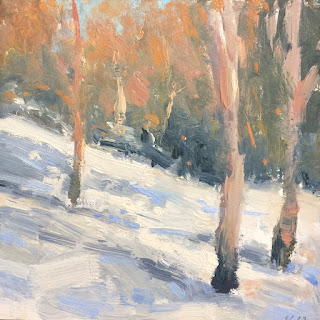As artists, we are always working within the confines of our
materials.
For 600 years, oil colors have been the preeminent medium of
visual expression. And within this time, the world has become increasingly more
colorful. We see this, not only in painting, but in the cars we drive and the
clothes we wear. As painters living and working today, we have more color
choices to us now compared to painters who came before us – a fact that is
equally intimidating as it is inspiring. How can we express a unique color
voice to make color our own?
This blog explores the evolution of painters’ most important
tool: COLOR. What aspects of colors do painters consider when selecting a
palette to express their artistic vision?
Artistic Intention
My own intentions as a landscape painter working in the Pacific
Northwest revolves around creating paintings which are informed by the area's
terrain, vegetation, water and sky. However, what I've always been drawn to,
visually, is to capture sensations of light and atmosphere - those fleeting
conditions in between downpours and sun, evening and twilight. In more recent
work, my characteristic softness of edge and ethereal transitions have given
way to a greater bravado of brushwork and more visible "hand" in the
mark-making.
Northwest Waters, 2011
Wetland in Spring, 2015
Evolving Color
One of the fascinating perspectives of looking at the
history and development of oil painting over the centuries, is to look at it
through the lens of how pigment technology evolved from classical era, through
the Industrial Revolution and through the 20th century. As artists,
we are always working within the confines of our materials.
As artists have incorporated new pigments into their work,
their access to color-mixing within Color Space has increased as well. This has
drastically expanded color possibilities in painting. Both in pigment chemistry
and in our use of color, we are no longer limited to the colorants and effects
from nature – we can push beyond this to explore color mixtures of higher
chroma for more expressive possibilities.
Classical Palette
Earth colors make up the heart of painters’ palettes during
the
Classical Era of pigment
history. This group of pigments, which has its origins in cave painting and
antiquity, was central to the oil painter’s palette from the Renaissance through
the Classical Era of oil painting. This limited range of muted earth colors
exists close to the “neutral core” of
Color Space.
Limited to this range of the color spectrum, painters depicted form by drawing
large contrasts between the darkest darks and the lightest lights, creating the
chiaroscuro (literally, “light/dark”) effect so characteristic of classical
paintings.
Impressionist Palette
The advancements of the Industrial Revolution of the
mid-nineteenth century widened the spectrum of both color and possibilities for
artists. A new range of pigments were made by fusing inorganic materials, such
as cadmium, cobalt, and chromium, together at very high heat. Not only did
these colors brighten the urban centers of the Iron Age, but they widened
painters’ access to color compared to the palettes of the Classical Era. For
the first time in history, painters of this period had the pigments available
to capture all of the colors of the natural world, expressed in the Impressionists’ interest in pure color.
The denser, tubed oil colors made from brighter and opaque pigments lent
themselves to the direct painting techniques so characteristic of the
Impressionists.
20th
Century Palette
The end of the 1800’s gave birth to the field of organic
chemistry with applications in the pharmaceutical, dye, and printing
industries. Modern organic pigments are characterized by their greater
transparency and their capacity to produce intense tints and mixtures.
The biggest difference in the characteristics between
mineral inorganic and modern organic colors–and arguably of most interest to
painters–is how these two groups of pigments behave differently in color mixing.
Below are two different reds, the mineral Cadmium Red Medium and modern Napthol
Red, each mixed with Titanium Zinc White.
As shown above, the mineral Cadmium Red Medium “greys down”
and loses its intensity as it is mixed with white, compared to the modern
Napthol Red, which retains its intensity in its tint. Once again, pigment
technology expanded painters’ access to Color Space and made it possible for
artists of the 20th Century
to create paintings of high chroma.
Personalized Color
Palette
Through my work at Gamblin I’ve gotten to know
the unique characteristics of artists’ pigments. Over the years, I’ve used this
insight to build a color palette that perfectly supports my color-mixing
intentions – to create paintings with a naturalistic color scheme, but to have
the capacity for bursts of more intense color.
Nickel Titanate
Yellow, Indian Yellow, Cadmium Orange, Alizarin Permanent, Ultramarine Blue,
Manganese Blue Hue.
My personalized color palette (shown here) is built off the
concept of a split primary palette (warm and cool for each primary color).
Instead of including a warm red, however, I use Cadmium Orange. This palette
not only balances warm and cool pigments, but mineral and modern, opaque and
transparent characteristics as well.
There a number of ways that we
develop a personal, unique voice and painters – technique, chosen subject
matter, and mark-making to name a few. Developing our own unique color voice
with a palette that balances theory and our own aesthetics is a valuable way to
make painting our own.
Buena Vista, 2015


































